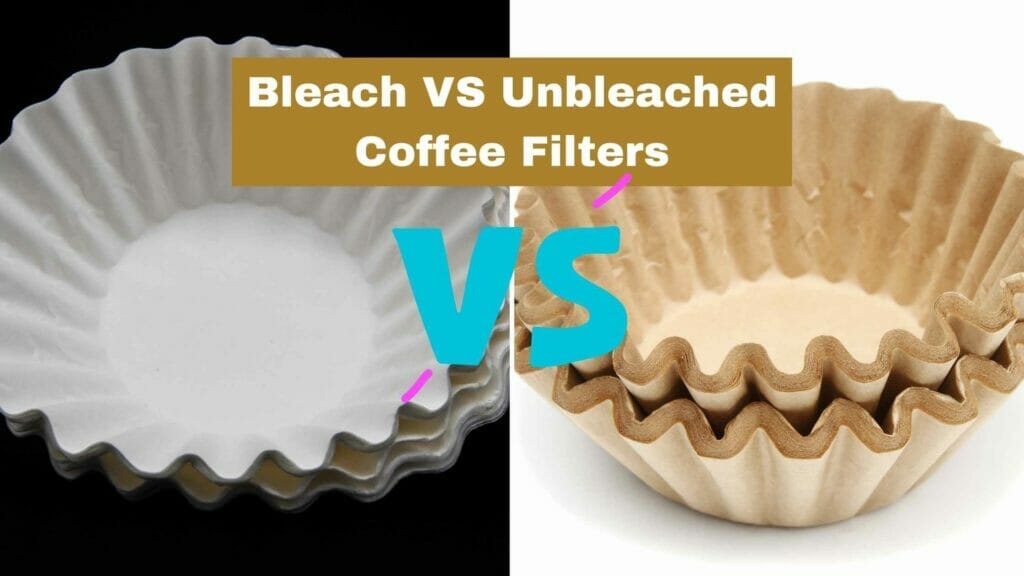
When it comes to making a perfect cup of coffee, every little detail counts. From choosing the right beans to selecting the perfect brewing method, coffee enthusiasts know that every decision can impact the final product. One decision that often goes overlooked is the type of coffee filter you use. Specifically, should you use bleached or unbleached coffee filters?
Bleached coffee filters have been whitened through chemical processes, such as chlorine or oxygen bleaching. On the other hand, unbleached coffee filters are made from natural, unbleached paper. While both types of filters serve the same purpose, there are notable differences between them that can impact the taste and quality of your coffee.
So, which type of filter should you choose? Let’s take a closer look at the debate between bleached vs unbleached coffee filters and help you make an informed decision.
Key Takeaways:
- Coffee Filter Types: There are two main types of coffee filters: bleached and unbleached. Bleached filters are whitened through chemical processes, while unbleached filters retain their natural brown color.
- Environmental Impact: Bleached filters require more resources to produce, including water and energy, which can have a significant impact on the environment. Unbleached filters are more eco-friendly as they require fewer resources.
- Taste Differences: Some claim that bleached filters can affect the taste of coffee due to chemicals leaving a residue, but this is subjective. The taste difference between the two types of filters is generally minimal.
- Personal Values: Choosing between bleached and unbleached filters depends on your personal values. If you prioritize eco-friendliness, unbleached filters may be preferable, while if you prefer a cleaner appearance, bleached filters might be more appealing.
- Unbleached Filters’ Benefits: Unbleached filters are made from sustainably managed forests without chemical treatments, making them more environmentally friendly. They are also biodegradable and compostable, often at a lower cost than bleached filters.
- Flavor Impact: The filter type can slightly affect the flavor of coffee. Bleached filters can result in a milder taste, while unbleached filters might allow more natural oils to pass through, resulting in a richer, fuller-bodied taste.
- Health and Environmental Considerations: Both filter types are generally safe for health, but unbleached filters are considered more eco-friendly due to the absence of chemical processing and their biodegradability. The environmental impact of bleached filters includes harmful chemicals and greater resource consumption.
Understanding Coffee Filters
When it comes to brewing coffee, coffee filters play a significant role in the quality, taste, and aroma of your cup of joe. Coffee filters are available in two primary types: bleached and unbleached. Both serve the same purpose, but there are notable differences between them.
Bleached coffee filters are whitened through chemical processes, such as chlorine or oxygen bleaching. On the other hand, unbleached filters are not chemically treated and retain their natural brown color.
One of the main differences between bleached and unbleached coffee filters is their environmental impact. Bleached filters require more resources to produce, including more water and energy, and can have a more significant impact on the environment. Unbleached filters, on the other hand, are more eco-friendly as they require fewer resources to produce.
Another difference is the taste of your coffee. Some people claim that bleached filters can affect the taste of coffee, as the chemicals used in the bleaching process can leave a residue on the filter. However, this is a matter of personal preference, and many people cannot tell the difference in taste between the two types of filters.
When it comes to choosing between bleached and unbleached filters, it’s essential to consider your personal values and preferences. If you prioritize eco-friendliness, unbleached filters may be the way to go. If you prefer a brighter, cleaner-looking filter, bleached filters may be more appealing.
Fun Fact: Did you know that coffee filters were invented by a woman? Melitta Bentz, a German housewife, invented the first coffee filter in 1908 using a brass pot and a piece of blotting paper.
Bleached Coffee Filters
When it comes to coffee filters, bleached and unbleached are the two primary types available. In this section, we will discuss bleached coffee filters, including their manufacturing process, pros and cons, impact on taste, and environmental impact.
Manufacturing Process
Bleached coffee filters are whitened through chemical processes, such as chlorine or oxygen bleaching. Chlorine bleaching is the most common method used to bleach coffee filters. It involves the use of chlorine gas or hypochlorite to whiten the paper. Oxygen bleaching, on the other hand, uses hydrogen peroxide or peracetic acid to whiten the paper.
Pros and Cons
One of the main advantages of bleached coffee filters is that they are more efficient at filtering out coffee oils and sediments. This results in a cleaner and brighter cup of coffee. Additionally, bleached coffee filters are less likely to impart any papery taste to the coffee.
However, there are also some drawbacks to using bleached coffee filters. The bleaching process can weaken the paper, making it more likely to tear or break during use. Furthermore, the chemicals used in the bleaching process can be harmful to the environment.
Impact on Taste
Bleached coffee filters have a minimal impact on the taste of coffee. While some coffee enthusiasts claim that bleached filters can impart a slight chemical taste to the coffee, this is generally not noticeable to most people. In fact, many coffee drinkers prefer the taste of coffee brewed with bleached filters because of their ability to produce a clean and bright cup.
Environmental Impact
The bleaching process used to produce bleached coffee filters can have a negative impact on the environment. Chlorine gas and hypochlorite are toxic and can cause harm to aquatic life if they are released into waterways. Additionally, the production of bleached coffee filters requires more energy and resources than unbleached filters.
Unbleached Coffee Filters
If you are a coffee drinker, chances are you have used paper filters to brew your coffee. While bleached coffee filters are more commonly used, unbleached coffee filters are becoming increasingly popular due to their eco-friendliness. In this section, we will take a closer look at unbleached coffee filters, including their manufacturing process, pros and cons, impact on taste, and environmental impact.
Manufacturing Process
Unbleached coffee filters are made from unbleached paper pulp. The paper pulp is made from a blend of hardwood and softwood trees, which are harvested from sustainably managed forests. The pulp is then mechanically processed to create the paper used to make the filters. No chemicals are used in the manufacturing process, making unbleached coffee filters a more natural option.
Pros and Cons
One of the main advantages of unbleached coffee filters is their eco-friendliness. They do not contain any harmful chemicals and are biodegradable, making them a better option for the environment. Additionally, unbleached coffee filters are often less expensive than their bleached counterparts.
However, there are also some disadvantages to using unbleached coffee filters. They may have a slightly brown color, which can be unappealing to some coffee drinkers. Additionally, unbleached coffee filters may be more prone to tearing than bleached filters.
Impact on Taste
Many coffee drinkers wonder whether unbleached coffee filters affect the taste of their coffee. While some people claim that unbleached filters produce a slightly different taste than bleached filters, the difference is generally minimal. The taste of your coffee is more likely to be affected by the quality of your beans, the brewing method, and the water you use.
Environmental Impact
Unbleached coffee filters have a lower environmental impact than bleached filters. They are made from sustainably managed forests and do not contain any harmful chemicals. Additionally, they are biodegradable and can be composted along with your coffee grounds.
Comparative Analysis
Flavor
When it comes to the flavor of your coffee, the type of filter you use can make a difference. Bleached filters tend to have a slightly milder taste than unbleached filters, which can have a more papery taste. However, this difference is often subtle and may not be noticeable to everyone. Ultimately, the flavor of your coffee will depend on many factors, including the type of beans, the roast level, and the brewing method.
Health Impact
Both bleached and unbleached coffee filters are considered safe for use, and neither type has been linked to any significant health risks. However, some people may be concerned about the potential for chemicals used in the bleaching process to leach into their coffee. If this is a concern for you, choosing unbleached filters may give you peace of mind.
Environmental Considerations
When it comes to the environment, unbleached filters are generally considered to be the more eco-friendly choice. Bleached filters require chemical processing, which can have negative environmental impacts. Additionally, some bleaching methods use chlorine, which is a known pollutant. Unbleached filters are often made from recycled paper and can be composted after use, making them a more sustainable option.
FAQ: Bleached vs Unbleached Coffee Filters
Are bleached coffee filters harmful to health?
There is no evidence to suggest that bleached coffee filters are harmful to health. The chemicals used in the bleaching process are carefully regulated by the FDA and the amount that may remain in the filter after manufacturing is negligible. However, if you are concerned about the potential risks, you can opt for unbleached coffee filters.
What is the difference between bleached and unbleached coffee filters?
The main difference between bleached and unbleached coffee filters is the method used to whiten the paper. Bleached filters are whitened through chemical processes, such as chlorine or oxygen bleaching, while unbleached filters are not treated with any chemicals. This difference can affect the taste and quality of your coffee, as well as the environmental impact of the filters.
Which is better for the environment: bleached or unbleached coffee filters?
Unbleached coffee filters are generally considered more environmentally friendly than bleached filters. This is because the bleaching process used to whiten the paper can release harmful chemicals into the environment. Additionally, unbleached filters are often made from recycled paper, which reduces waste and conserves resources.
Do unbleached coffee filters affect the taste of coffee?
Unbleached coffee filters can affect the taste of coffee, as they allow more natural oils and flavors to pass through the filter and into your cup. This can result in a richer, more full-bodied coffee with a slightly earthy taste. However, some people may find that unbleached filters leave a papery taste in their coffee, especially if the filters are not rinsed before use.
What are the benefits of using oxygen-bleached coffee filters?
Oxygen-bleached coffee filters are a type of bleached filter that uses oxygen instead of chlorine to whiten the paper. This process is considered more environmentally friendly than chlorine bleaching and produces a filter that is free of harmful chemicals. Oxygen-bleached filters can also produce a cleaner-tasting coffee than unbleached filters, as they do not allow as many natural oils and flavors to pass through the filter.
How can you tell if a coffee filter is bleached or unbleached?
The easiest way to tell if a coffee filter is bleached or unbleached is to look at the color of the paper. Bleached filters are usually bright white, while unbleached filters are a natural, light brown color. Additionally, many manufacturers will label their filters as either bleached or unbleached, so you can check the packaging for more information.
